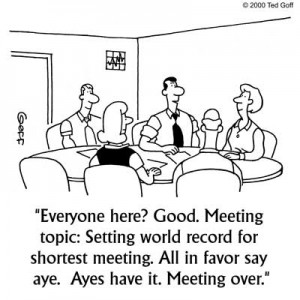 There are a lot of things that people do without completely understanding the reason for doing those things. Meetings definitely fall into this category. Have you ever analysed “meetings”? Have you ever wondered why we have meetings? What is their purpose and why do they matter? If we don’t know the purpose of holding meetings, then how can we have effective meetings?
There are a lot of things that people do without completely understanding the reason for doing those things. Meetings definitely fall into this category. Have you ever analysed “meetings”? Have you ever wondered why we have meetings? What is their purpose and why do they matter? If we don’t know the purpose of holding meetings, then how can we have effective meetings?
Unfortunately, neither professionals nor managers tend to question the purpose of meetings. Corporations like Google and Facebook did which is precisely why they are known for having highly effective meetings and cited as perfect examples that other companies should aspire to.
Finding the purpose of meetings isn’t all that complicated. The moment you wonder about it is the moment you’ll discover it. The purpose of a meeting is to ensure that everyone involved in a project or a company knows the overall objectives and their specific role in achieving those objectives.
Why Try To Ensure Effective Meetings Instead Of Scrapping Them Altogether?
 Brainstorming, presentations, and debates help with finding those objectives while delegations and allocations help define every individual’s job. Unfortunately, meetings have come under a lot of flak in recent years from so-called gurus of management.
Brainstorming, presentations, and debates help with finding those objectives while delegations and allocations help define every individual’s job. Unfortunately, meetings have come under a lot of flak in recent years from so-called gurus of management.
Their suggestion is that businesses should just scrap the whole idea of physical meetings and instead start relying on digital communication technologies such as emails, business web chat applications, and video conferences.
If business dynamics such as lower costs or logistical issues force your business to have virtual meetings, then by all means use the benefits of technology. However, if your employees can be in the same room, then instead of removing physical meetings from the picture you should try to hold effective meetings.
There are many benefits of physical meetings over virtual meetings provided you ensure that they are effective meetings. Some of these benefits of physical meetings are lower instances of miscommunications, reduced distractions, more commitment, and better networking opportunities.
So, how do you go about holding effective meetings? How do you turn meetings from being a drain on your business’s resources and employees’ time, to the foundation for success? Here are some tips.
Announce Agenda Well In Advance
 One of the simplest methods of streamlining meetings is by announcing an agenda well in advance. This allows every participant to come prepared to the meeting. While simple, setting an agenda is something that most businesses fail to focus on.
One of the simplest methods of streamlining meetings is by announcing an agenda well in advance. This allows every participant to come prepared to the meeting. While simple, setting an agenda is something that most businesses fail to focus on.
This results in precious time being wasted during meetings when individuals take time to formulate their responses and contributions. Even worse, sometimes the responses are incomplete or ambiguous with a rider: “I’ll get back to you on this.”
This doesn’t only make the meeting ineffective but also pointless. Therefore, if you want to hold effective meetings, the first thing you need to make a habit out of is setting an agenda for each and every meeting.
Always Have Someone Lead or Moderate the Meeting
 Setting an agenda gives a meeting direction. However, it isn’t by itself because you need someone to keep the meeting going in the direction that was chosen for it. This is the objective of a meeting leader or moderator.
Setting an agenda gives a meeting direction. However, it isn’t by itself because you need someone to keep the meeting going in the direction that was chosen for it. This is the objective of a meeting leader or moderator.
It is not that uncommon for a meeting to diverge from the path that was set out for it. It is at this moment that the moderator or meeting leader has to decide whether the diversion is worth it or not. If he finds the diversion to not be worth it then he can initiate course correction for the meeting.
A lot of time is wasted when meetings meander. However, installing moderators and meeting leaders can guarantee effective meetings and save tons of time for a business.
Try Removing Technology from the Picture
 Technology is supposed to be a tool that saves time, energy, and money. However, because technological development has become faster than industry adaptation, the majority of the work force of most business is not unable to cope with new devices.
Technology is supposed to be a tool that saves time, energy, and money. However, because technological development has become faster than industry adaptation, the majority of the work force of most business is not unable to cope with new devices.
This results in time and resources being wasted on figuring out the new technology during meetings. Haven’t you ever been in a meeting where one or more participants have wasted minutes on trying to make a projector work?
Therefore, if you don’t have the youngest work force and think that your conference rooms don’t need new technology, then one of the ways through which you can guarantee effective meetings is by giving latest devices wide birth.
Only Involve As Many People as Essential
 Lesser individuals almost always have effective meetings. This is why the idiom “too many cooks spoil the broth” exists. Too many people in a single meeting means multiple clashing opinions or, at the very least, alternative opinions.
Lesser individuals almost always have effective meetings. This is why the idiom “too many cooks spoil the broth” exists. Too many people in a single meeting means multiple clashing opinions or, at the very least, alternative opinions.
This means that the decision making process is slower and more cumbersome. Moreover, the more the number of people involved, the higher the chances are that the meeting will diverge from the chosen subject.
Therefore, if you want to have effective meetings, then you should only involve only as many as is absolutely essential for the project in question. Typically, a meeting should not involve more than seven people with four to five individuals the ideal figure.
Establish a Strict Schedule
 If there’s one thing that most professionals tend to be cognisant of, then it is deadlines. Therefore, an incredibly easy way to prevent your employees from diverging from the chosen agenda of the meeting is to set deadlines.
If there’s one thing that most professionals tend to be cognisant of, then it is deadlines. Therefore, an incredibly easy way to prevent your employees from diverging from the chosen agenda of the meeting is to set deadlines.
First and foremost, you should set a start time and end time. In addition to this, you should limit the speaking time of every participant depending upon the topics being discussed. Further, if you have multiple topics to discuss, you should set time limits on each of those as well.
Try to adhere to such strict schedules even if the discussion on a particular topic isn’t complete. Initially, you may have teething issues but, sooner or later, everyone will get the idea.
Keep Meetings as Short As Possible
 Apart from keeping a strict schedule, it is also advisable to keep your meetings short. Regardless of the topics being discussed, research has shown that the most effective meetings don’t run longer than one hour.
Apart from keeping a strict schedule, it is also advisable to keep your meetings short. Regardless of the topics being discussed, research has shown that the most effective meetings don’t run longer than one hour.
Usually, one hour is more than enough for a competent team to discuss a subject, come up with a plan of action, and even allocate relevant tasks to participants.
The reason why one hour limit is ideal for effective meetings is that it forces participants to focus and be alert. The limit reduces random chit chats, divergences, and even pointless questions.
Eradicate Update Based Meetings
 The antithesis of effective meetings is update based meetings. Some business owners have this tendency to hold meetings just to get updates on previously assigned tasks.
The antithesis of effective meetings is update based meetings. Some business owners have this tendency to hold meetings just to get updates on previously assigned tasks.
The purpose of such meetings is more stoking the boss’s ego than completing some project.
After all, giving updates via emails and internal memos is much more efficient than holding pointless meetings.
Utilise the Last Few Minutes to Summarise
The last five or ten minutes of all effective meetings are used for summarising the discussion. A recap in the end of a meeting means that everything is recalled and remembered well by the end.
Without a summary of the discussion being provided at the end of a meeting, there could be confusion about what was discussed. Therefore, if you truly want to incorporate effective meetings into your business’s existing operations, then you should incorporate summary sessions at the end of every meeting.
Leave a Reply